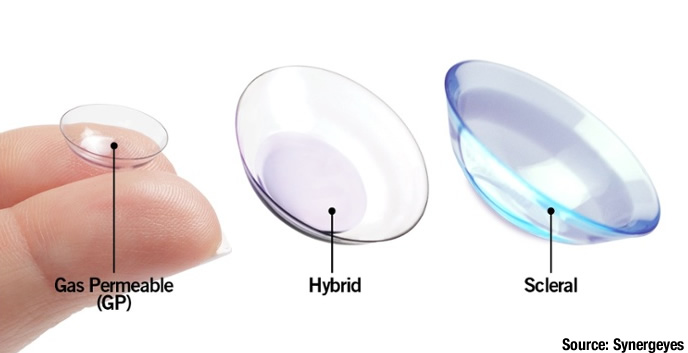Specialty Contact Lenses
Dr. Brooks has extensive experience with specialty contact lenses since 2007.
This started while he worked with corneal surgeon Mark Gorovoy, MD (from 2007-2013) before starting Brooks Eye Care in 2014. Dr. Brooks gets referrals regularly from local ophthalmologists and optometrists including other specialty contact lens providers. Referrals come from Port Charlotte to Naples and sometimes further. Unlike some eye doctors who see a specialty lens patient every few weeks, Dr. Brooks will average two to three specialty lens patients a day.

Three common types of specialty contact lenses are scleral, gas-permeable (GP), and hybrid contact lenses. These custom-made lenses are often used for patients who have irregular corneas caused by corneal disease (such as keratoconus), corneal scarring or failed refractive surgery. These patients can not see clearly with glasses or soft contact lenses because the surface of the eye (the cornea) is warped and distorts light entering the eye. These specialty lenses are made with a rigid gas-permeable material that maintains a smooth/round shape, providing clear vision even when the cornea shape is warped.
Every patient is different and it often takes several follow-up visits to find a lens design that works well. The results when successful, are very rewarding for the patient and eye doctor. These lenses can have a dramatic impact on the function and life of patients with corneal irregularities.
Scleral Lenses
Because scleral lenses vault over the cornea and land on the less sensitive sclera (white of the eye), the comfort is typically very good. Scleral lenses are usually the best option for patients with severe corneal irregularities. Severe dry eye syndrome can also be treated with scleral lenses, since the vaulted area over the cornea is filled with preservative free saline and creates a fluid reservoir.
Since 2011, Dr. Brooks has treated over 800 patients with scleral lenses. In 2011, scleral lenses were just starting to gain widespread clinical use. Dr. Brooks has used multiple scleral lens designs and was a beta tester for BostonSight Smart 360 freeform scleral lenses in 2022. Freeform scleral lenses are designed from elevation scans of the cornea and sclera to provide a more customized fit.
Gas-Permeable (GP) Lenses
GP lenses offer sharp vision and correct most vision problems. They are more durable than soft contact lenses and can be easier to handle and care for but require a longer adaptation period and consistent wear to maintain adaptation.
Hybrid Lenses
Have a rigid center with a soft skirt around the periphery. The only hybrid currently on the market is Synergeyes. Hybrid lenses offer the benefits of GP lenses (sharp vision) and soft lenses (improved comfort).